 advertisements advertisements
|

|
First recovered US rocket stage returned to its launch site for display
January 19, 2023 — The first U.S. rocket stage to be recovered after its launch has landed a new home not far from where it lifted off almost 60 years ago.
The Cape Canaveral Space Force Museum on Thursday (Jan. 19) took delivery of the booster segment that helped launch NASA astronauts Gordon Cooper and Charles "Pete" Conrad on the Gemini-Titan 5 (GT-5) mission on Aug. 21, 1965. The 27-foot-long (8-meter) section of the Titan II rocket first stage had been at the U.S. Space and Rocket Center in Huntsville, Alabama.
"The U.S. Space Force Historical Foundation has secured one of the most historically significant artifacts related to America's early crewed space programs," the organization stated in a release. "It is the only recovered booster from the entirety of America's early crewed space programs, from Mercury through Apollo! Its inclusion in the museum's expanding artifact collections will help generations to come understand Cape Canaveral's unique role in space history. This is where history is launched!"
The artifact, which encompasses the upper portion of the Titan II rocket's first stage, flew with the vehicle from Launch Complex 19 at Cape Kennedy (today Cape Canaveral) in Florida for the first two and a half minutes of flight, reaching about 50 miles high (80 kilometers) before its two-nozzle engine exhausted its propellant supply. Unlike most rockets, which jettison their first stage before firing their second stage engine(s), Gemini-Titan "fired in the hole," igniting the upper stage before separating from the first.
The Titan II first stage then plunged back to Earth, impacting the Atlantic Ocean off the coast of Bermuda with no plans for its recovery. It was only by happenstance that a U.S. Air Force plane spotted the segment floating in the water, which led to a U.S. Navy destroyer, the U.S.S. Du Pont, hauling it out of the ocean and back to shore.
Whether the surviving segment, which housed the booster's oxidizer tank, tore apart from its fuel tank and engine section during the tumble back to Earth or on contact with the ocean is unknown. The lower section of the stage presumably sank to the seafloor.
The portion that was recovered was partially flattened but otherwise intact. Part of the lettering that spelled out "United States" running vertically down the length of the stage was — and still remains — visible.
The stage was the first and only U.S. booster to be recovered until the space shuttle began flying in 1981 with two side-mounted solid rocket motors that were designed to be serviced and reused. Since then, the private spaceflight company SpaceX has demonstrated the ability to land and reuse its Falcon 9 rocket's first stage, achieving its 166th successful recovery on Thursday, just about the same time as the GT-5 stage was being delivered.
The U.S. Space Force Historical Foundation funded the stabilization, new display cradle and transportation of the booster from Huntsville to the Cape.
The Titan II flown segment will now be displayed inside Hangar C at the Cape Canaveral Space Force Station (previously Air Force Station). Built in 1953, the renovated hangar today serves as an indoor exhibit space for the Cape Canaveral Space Force Museum (previously Air Force Space and Missile Museum), housing various examples of missiles and rockets launched from the Cape.
The Gemini 5 spacecraft, which carried Cooper and Conrad into orbit and back, is today displayed at Space Center Houston in Texas, on loan from the Smithsonian. The Cape Canaveral Space Force Museum exhibits the Gemini 2 capsule, the first U.S. spacecraft to be launched twice in support of the Air Force's planned Manned Orbital Laboratory (MOL).
Though the GT-5 stage is the only flown display, Gemini-Titan II rockets comprised of leftover hardware and mockups from can be seen at NASA's Kennedy Space Center Visitor Complex in Florida, the Cosmophere space museum in Kansas and the Stafford Air and Space Museum in Oklahoma. The only remaining Titan II SLV (space launch vehicle) is on exhibit at the Evergreen Aviation and Space Museum in Oregon. |
|
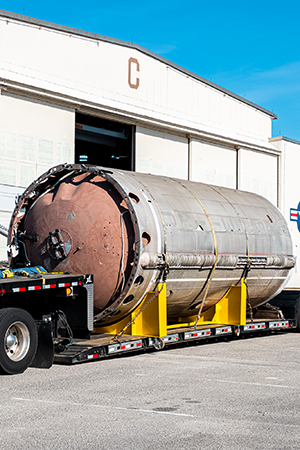
A 27-foot-long (8-m) segment of the Titan II rocket that launched NASA's Gemini 5 mission in 1965 and became the first U.S. rocket stage to be recovered intact was delivered to the Cape Canaveral Space Force Museum in Florida for its preservation and display on Thursday, Jan. 19, 2023. (Trevor Mahlmann)
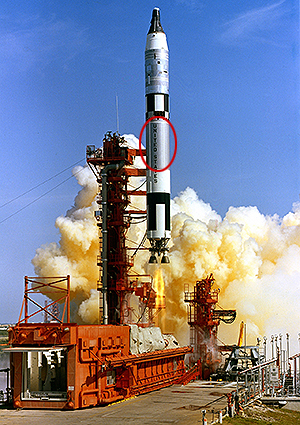
The launch of Gemini 5 on Aug. 21, 1965 from Complex 19 at Cape Kennedy, Florida. The segment of the first stage that was recovered from the ocean is circled in red. (NASA) |
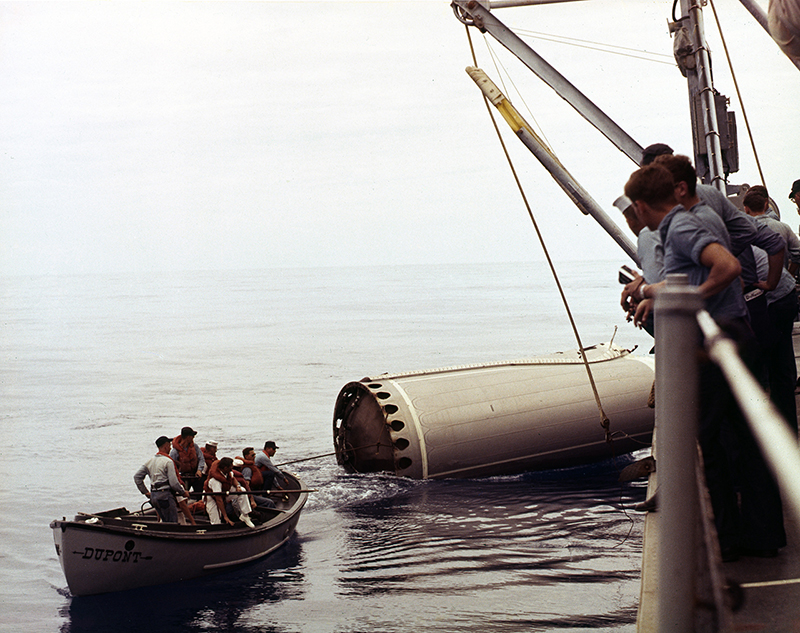
Sailors tow a segment of the Gemini-Titan 5 rocket's first stage to the U.S. Navy destroyer U.S.S. Du Pont to be brought back to shore. (NASA) |
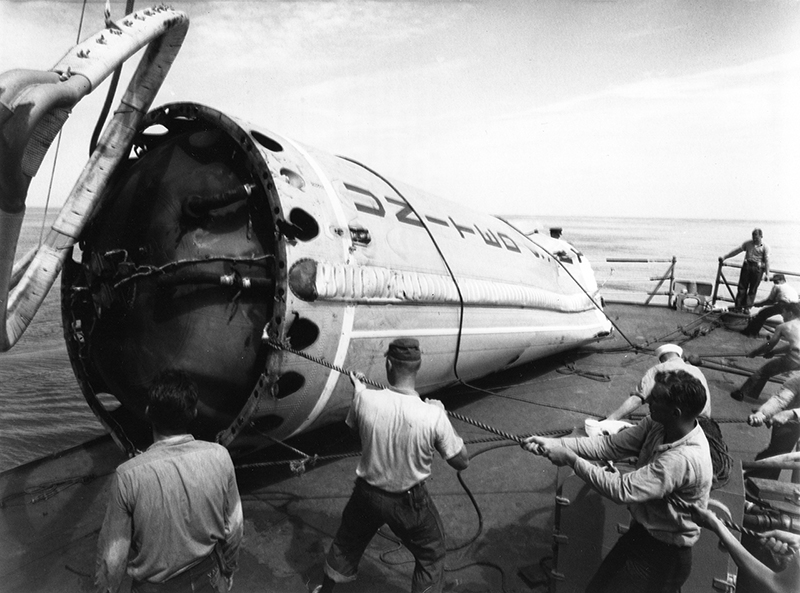
Sailors haul the Gemini-Titan 5 first stage segment onto the deck of the U.S.S. Du Pont for the booster's return trip to the shore for study. (NASA) |
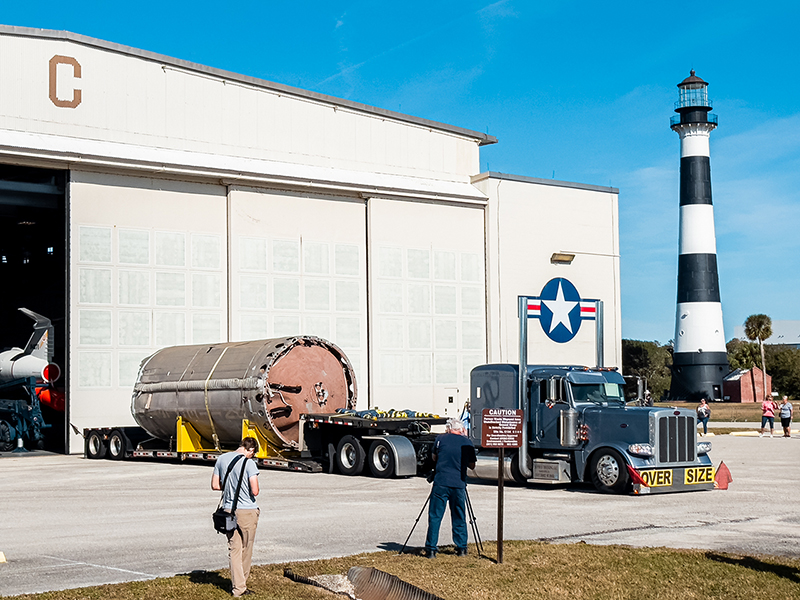
A segment of the Titan II first stage that launched NASA's Gemini 5 mission arrives at Hangar C to go on display as part of the Cape Canaveral Space Force Museum's collection in Florida on Thursday, Jan. 19, 2023. (Trevor Mahlmann) |
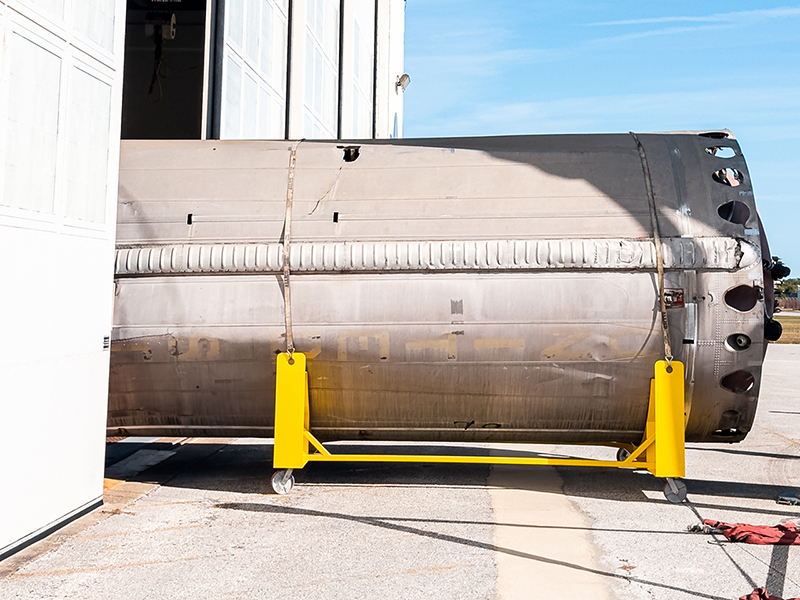
The 58-year-old Titan II segment is moved into Hangar C, the oldest structure of its type at Cape Canaveral Space Force Station. (Trevor Mahlmann) |

The view inside the Titan II first stage segment. This section of the stage held the oxidizer for the two-nozzle engine at its base. (Trevor Mahlmann) |

The bulkhead for the Titan II first stage oxidizer tank, as seen 58 years after its unplanned recovery from the Atlantic Ocean. (Trevor Mahlmann) |
|

© 1999-2025 collectSPACE. All rights reserved.
|
|

|

|
